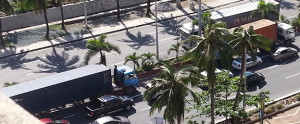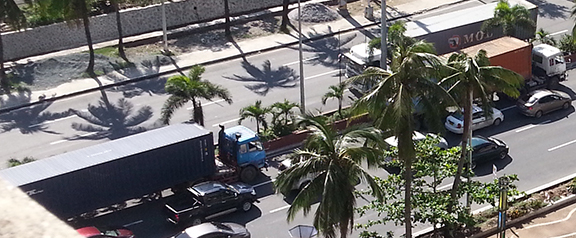 The Philippine economy lost P43.85 billion from the impact of the seven-month truck ban imposed by the Manila City government last year, according to a government think tank.
The Philippine economy lost P43.85 billion from the impact of the seven-month truck ban imposed by the Manila City government last year, according to a government think tank.
On February 24 last year, Manila City Council Ordinance No. 8336 was implemented, banning trucks from plying Manila roads from 5 a.m. to 9 p.m. Following protests, serious gridlocks, and port congestion, Manila eventually allowed a concession period between10 a.m. and 3 p.m., and after months of implementation, indefinitely lifted the ordinance on September 13.
The Philippine Institute for Development Studies (PIDS), in a discussion paper titled “A System-wide Study of the Logistics Industry in the Greater Capital Region” released on March 18, said the cost estimate was broadly broken down as P22.55-billion revenue loss for the Bureau of Customs (BOC), P18.2 billion in output losses, and P100 million in vehicle operating costs.
Citing BOC, the study authors said that following the ordinance, revenue collection declined considerably at the Port of Manila (POM) and Manila International Container Port (MICP), BOC’s two largest collection districts which together account for 48% of total revenue collections. MICP revenue collection saw a 27% decline, while POM registered a 47% decrease.
There were also employment and output losses sustained by manufacturing firms in economic zones, the study noted.
“Evidently, the Manila Truck Ban triggered congestion at the port of Manila and adversely affected exporters, importers, and manufacturers whose operations (had) been disrupted and (faced) increasing transport cost,” it stated.
Freight forwarders, logistics services providers, shipping lines, truckers, and terminal operators were likewise affected, since congestion at the Port of Manila led to difficulties in off-loading cargoes, resulting in delays and a longer waiting time, the study added.
“On the other hand, the Manila Truck Ban was instigated by the congestion of Manila’s streets caused by huge cargo traffic coming in and out of the Port of Manila, the lack of depot by shipping lines for their containers, and the lack of depot for cargo trucks which use Manila’s streets as their parking garages,” it noted.
The PIDS team surveyed 17 shippers and consignees, 19 freight forwarders and service providers, and 20 truckers regarding the effects of the Manila truck ban.
The responses of the shippers and consignees showed that the truck ban spurred delays in the arrival of their imports that led to losses. Increases in transport costs and delays in shipping out exports were also cited as major concerns. Other effects mentioned included production delays, shutdowns due to non-arrival of imported materials, increase rental fees for forklifts, overtime costs, and increase in warehousing fees.
Trucking costs were another key issue as these doubled from P18,000 before the truck ban to P36,000 after implementation. The port congestion that resulted from the truck ban led to delays in cargo releasing from the usual three to four days to seven to 10 days, the study noted. However, truckers said that despite the higher price of trucking services, big players only broke even because turnarounds became fewer. The truckers were still able to earn P21,000 on average per week with only one turnaround instead of the previous three, the study said.
Aside from the truck ban, truckers also cited other policies implemented in 2014 that contributed to the slower truck turnaround and artificial truck shortage. These included red tape, slow processing of yellow-plate applications, and delayed release of these plates. Truckers also faced a number of fees and charges which still existed even after the truck ban’s lifting, such as those from “rent-seeking traffic enforcement encountered by truck drivers when on the streets of Metro Manila.”
A series of focused group discussions held on July 15 and July 22, August 22, and September 10, 2014 with 25 people from 21 companies and a customs broker identified other issues and challenges faced by the Port of Manila and the logistics system as a whole. Among these were port congestion, empty and overstaying containers, lack of container depot areas, imposition of truck bans, and enforcement of yellow plates.
Recommended remedies
To help ease port congestion and prevent its recurrence, the study recommended short-, medium, and long-term solutions for the government and private sector to undertake.
For the short term, the PIDS group called for the issuance of a policy that will put a cap on the capacity of Manila ports and mandate that cargoes bound for or coming from the south of Manila should call at the Batangas Port and those bound for or coming from the north should call Subic Port. This is similar to recommendations of some previous studies on the Metro Manila and greater Luzon transport situation.
MICP port operator International Container Terminal Services, Inc. (ICTSI) was also urged to revive during off-peak hours its rail freight operations leading to its inland container depot (ICD) in Calamba, Laguna. ICTSI recently opened the first phase of the Laguna ICD and said it will later connect it to the rail system.
The PIDS team also supported the roll-out of the 24-hour web-based integrated truck dispatching, appointment, and booking system to improve the logistics chain. This system, called the vehicle booking system or truck appointment system by port operators, is targeted to be launched by the second or third quarter of this year, according to ICTSI head for Asia, the Pacific and Subcontinent Christian Gonzalez in an earlier interview with PortCalls.
For the medium term, diversion of volume from the Manila port to Subic and Batangas ports was proposed. To complement this, the study saw a need to increase the number of BOC and Philippine Ports Authority personnel at these ports, and to expand the fleet of cargo-handling equipment, berths, and container yard capacity at Batangas port.
The group also sought a rationalization plan for port development and investment programs in the Greater Capital Region; creation of an inter-agency land identification and acquisition committee to identify and inventory potential port relocation or expansion sites; and the gradual rehabilitation of the Philippine National Railway line so it can be used to move empty, unclaimed, and abandoned containers to an inland container yard.
For the long term, a multimodal transport and logistics development plan with special emphasis on interconnectivity within the Manila-Sorsogon-Leyte-Surigao corridor was recommended.
Moreover, construction of a large deep-sea port at the location site identified by the multimodal transport and logistics development plan will be needed.
Creating investment plans for new rail, maritime, port, airport, and road infrastructures to link domestic ports to the global supply chains is another long-term suggestion.
In a related development, the private sector spearheaded by the Philippine International Seafreight Forwarders Association and United Portusers Confederation, is currently drafting the Philippine Multimodal Transport and Logistics Roadmap which will likely be finalized by May. – Roumina Pablo





